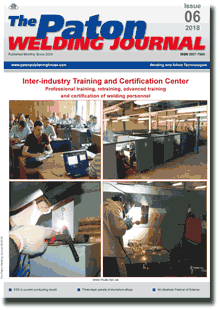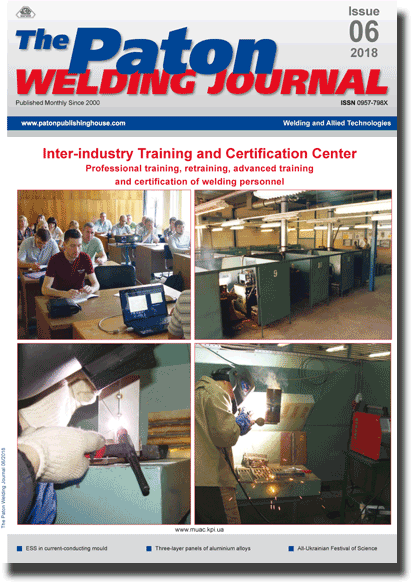| 2018 №06 (05) |
DOI of Article 10.15407/tpwj2018.06.06 |
2018 №06 (01) |

The Paton Welding Journal, 2018, #6, 40-42 pages
High speed friction welding of titanium alloys — structure and properties of joints
D. Miara1, J. Matusiak1, A. Pietras1, M. Krystian2 and M. Dyner3
1Institute of welding 44-100, Gliwice, Str. Bl. Czeslava 16-18, Poland. E-mail: adam.pietras@is.gliwice.pl
2Austrian Institute of Technology Str. Giefinggasse 4, 1210, Vienna, Austria. E-mail: marciej.krystian@univil.ac.at
3Plant of Medical Instruments CHIRMED Str. Mstowska 8A, 42-240 Rudniki, Czestochowy, Poland. E-mail: m.dyner@chirmed.pl
The article presents test results concerning the high speed friction welding (HSFW) of titanium alloys Ti64 ELI and CP-Ti. In addition, the article presents tests results related to the welding process and the formation of flash. The quality of welds was assessed on the basis of non-destructive tests (visual tests) and destructive tests (static tensile tests and bend tests). The tests resulted in the identification of the correlation between HSFW conditions when joining titanium alloys, i.e. Ti64 ELI, CP-Ti, and the quality of welds. Consequently, the tests led to the determination of the optimum range of welding parameters as regards the strength of joints. 8 Ref., 2 Tables, 6 Figures.
Keywords: friction welding, titanium alloys, structure and properties
Received: 11.04.18
Published: 05.07.18
References
- (2016) Project Anti-bacterial optimization of high-strength, severe-plastic-deformed titanium alloys for spinal implants and surgical tools — SPD-BioTribo) www.M-ERA.NET/2015/02/2016 (2016-09-2018-08-31) report no. 2.
- Zadroga, L., Pietras, A., Papkala, H. (2004) Studium i badania warunków łączenia materiałów różnoimiennych nowoczesnymi metodami zgrzewania tarciowego. Report of Research Instytutu Spawalnictwa, Gliwice.
- Klimpel, A. (1999) Technologie zgrzewania metali i tworzyw termoplastycznych. Wydawnictwo Politechniki Śląskiej, Gliwice.
- Michalski, R., Kamiński, Z. (1975) Zgrzewanie tarciowe. WNT, Warszawa.
- Michalski, R. (1980) Typizacja procesu zgrzewania tarciowego. Praca badawcza nr T-17, Instytut Spawalnictwa, Gliwice.
- Materials of HARMS & WENDE.
- (2013) PN-EN ISO 17639:2013-12: Badania niszczące spawanych złączy metali – Badania makroskopowe i mikroskopowe złączy spawanych.
- (2013) PN-EN ISO 4136:2013-05E: Badania niszczące złączy spawanych metali – Próba rozciągania próbek poprzecznych.
Suggested Citation
D. Miara, J. Matusiak, A. Pietras, M. Krystian and M. Dyner (2018) High speed friction welding of titanium alloys — structure and properties of joints. The Paton Welding J., 06, 40-42.The cost of subscription/purchase order journals or individual articles
| Journal/Currency | Annual Set | 1 issue printed |
1 issue |
one article |
| TPWJ/USD | 384 $ | 32 $ | 26 $ | 13 $ |
| TPWJ/EUR | 348 € | 29 € | 24 € | 12 € |
| TPWJ/UAH | 7200 UAH | 600 UAH | 600 UAH | 280 UAH |
| AS/UAH | 1800 UAH | 300 UAH | 300 UAH | 150 UAH |
| AS/USD | 192 $ | 32 $ | 26 $ | 13 $ |
| AS/EUR | 180 € | 30 € | 25 € | 12 € |
| SEM/UAH | 1200 UAH | 300 UAH | 300 UAH | 150 UAH |
| SEM/USD | 128 $ | 32 $ | 26 $ | 13 $ |
| SEM/EUR | 120 € | 30 € | 25 € | 12 € |
| TDNK/UAH | 1200 UAH | 300 UAH | 300 UAH | 150 UAH |
| TDNK/USD | 128 $ | 32 $ | 26 $ | 13 $ |
| TDNK/EUR | 120 € | 30 € | 25 € | 15 € |
AS = «Automatic Welding» - 6 issues per year;
TPWJ = «PATON WELDING JOURNAL» - 12 issues per year;
SEM = «Electrometallurgy Today» - 4 issues per year;
TDNK = «Technical Diagnostics and Non-Destructive Testing» - 4 issues per year.


